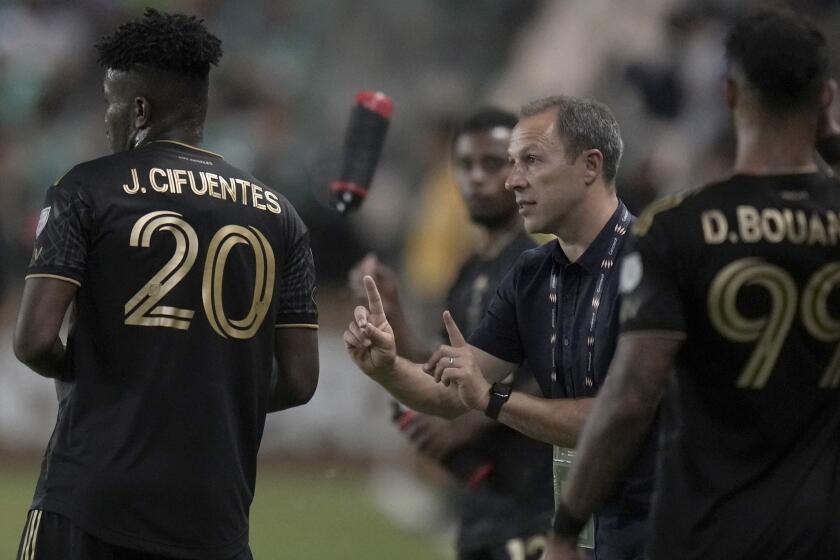COLUMN ONE : Prep Sport--Putting Fun Back : Standards of conduct sink among players, and coaches bear much of the blame. Some are trying to re-instill the lesson that winning isn’t everything.
Some of the biggest problems facing prep sports these days--unsportsmanlike conduct, poor leadership by coaches, a general lack of perspective and the specter of litigation in resolving disputes--converged last year after Canyon High School lost a football playoff game to Santa Barbara High.
Provoked by a referee’s mistake that prevented them from winning in regulation time and taunted by Santa Barbara fans after their 28-27 overtime loss, the Canyon Cowboys went on a rampage in the visitors’ locker room, breaking two doors, a trophy case, a drinking fountain and a blackboard.
Canyon Coach Harry Welch later admitted that it was he who smashed the trophy case. “I was in a rage,” Welch says, adding that he’s “not proud of it.”
Canyon High, in Canyon Country, paid for damages and reprimanded Welch, but the incident did not end there. Members of the Cowboys football community, including parents and boosters, seemed to be more upset about the team’s elimination from the playoffs than about the team’s behavior. They raised $7,300 to seek a restraining order to overturn the loss, a movement that stopped only when the William S. Hart Union High School District trustees voted not to sue.
High school sports used to have a veneer of purity and innocence--pink-cheeked kids playing for Small Town U.S.A. on crisp autumn nights--but no longer.
“There’s a growing concern that things are getting a little out of hand,” says Bruce Howard, a spokesman for the Kansas City-based National Federation of State High School Assns., the governing body of prep sports.
It is now feared that the problems inherent in pro and college sports have penetrated deeply into the prep ranks during the last decade. The 1980s, officials say, were marked by a disturbing decline in prep sportsmanship. Other troubling signs include illegal recruiting; an increase in steroid use; a trend among basketball fans and cheerleaders to boo opposing players at the foul line; an overemphasis on winning; mean-spirited, in-your-face competition, and what prep officials see as an alarming tendency to resolve disputes in the courtroom instead of on the court.
The beleaguered 476-school Southern Section, this region’s arm of the California Interscholastic Federation, suffered through a rash of lawsuits during football playoffs last season. In one memorable week, it went to court five days in a row to litigate cases brought by angry boosters and parents who had been upset by Southern Section rulings that went against their teams.
“Where are sports going?” asks Ed Bates, who runs a progressive youth athletic program at the Woodland Hills Recreation Center. “Are there any values left?”
Bates is part of a loose coalition that is not only asking questions but trying to provide the answers. Concerns and doubts about sports first surfaced in the late 1960s--when books by such so-called radicals as Jack Scott and Dave Meggyesy criticized organized sports for being dehumanizing--but only in the last few months has the semblance of a national movement taken on any momentum.
“We’ve just now instituted an awareness campaign to get states to refocus on the real goals of high school sports,” says Howard, whose organization establishes--but does not mandate--guidelines for athletic programs at more than 18,000 high schools.
But the national high school association’s effectiveness in launching such a campaign is in doubt. Last summer, when the association tried to make a “return to sportsmanship” the theme of its national convention, the message didn’t seem to get out.
“Sportsmanship was supposed to be the theme,” says Dean Crowley, a Southern Section administrator, “but it’s really fallen through.”
It certainly did last autumn in the Southern Section, which experienced more severe incidents in football than normal. The worst occurred in the fourth quarter of a scoreless game at the College of the Canyons, when Palmdale High players Darius Wilson and Michael Warren attacked two referees, knocking them to the turf. What ignited the fracas were three consecutive penalties against Palmdale--but there seems to be more involved than just frustration. Throughout the game, according to observers, Saugus High players taunted Palmdale with racial slurs.
“Fights, open cheating, recruiting of athletes--we as educators have a job to do to get things back in perspective,” says Tom Jacobson, principal at Corona del Mar High and president of the Southern Section Council.
It probably comes as no surprise that coaches are taking most of the heat for the problems in prep sports. Coaches are expected to lead by example--but sometimes the example has fallen embarrassingly short, as it did last season with Welch and in 1985, when Grant High Coach Jeff Engilman was fired for allegedly drawing a vagina on a blocking dummy and ordering his players to use it as a target.
“By this summer,” Howard says, “we’ll be implementing a nationwide education program for coaches to give them more insight into what they’re doing.”
The Amateur Athletic Foundation is going after coaches, too. “We’ve found that so many of them don’t have a clue,” says AAF President Anita DeFrantz.
The AAF, a Los Angeles-based nonprofit organization mandated to serve youth sports in Southern California, has the potential to wield tremendous influence over sports, considering the West Coast’s knack for starting nationwide trends. Backed by a $92-million war chest--the surplus from the 1984 Olympics--the AAF is committed to carrying its philosophy to the sports world.
“Kids first, winning second,” DeFrantz says.
The AAF, which has distributed $25 million to youth groups in the last five years, has the muscle to get what it wants. Before a group can qualify for a grant, it must agree to teach sports the foundation’s way.
“We want to make sure they offer programs that don’t overemphasize competition,” says Judith Pinero, AAF vice president in charge of programs and grants.
The AAF has been training coaches in all sports since 1986, but did not begin an extensive pilot program for high school coaches until last summer. It started with prep soccer, the most problem-plagued sport in the Southern Section. During the 1983-84 season--a season so bad that the sport was put on probation--there were 29 fights involving two or more players, 36 games suspended because of problems on the field or in the stands, 62 games forfeited because of ineligible players, 12 coaches ejected and two coaches sanctioned for striking opposing players.
But if the sport was in a state of anarchy, the fault belonged to the coaches, the AAF determined. It learned that 80% of the soccer coaches in the Southern Section were not faculty members but walk-ons, “someone whose prime motivation is to get kids to win, and who doesn’t look at things in a broader perspective,” Pinero says.
Last summer, the AAF sponsored three four-day, 32-hour free clinics for about 300 prep soccer coaches. Part of each clinic was set aside for sports psychologists to explain the foundation’s philosophy to the coaches.
“We spent a long time talking about TLC: teaching, learning, competition,” Pinero says.
This year, the foundation hopes to train another 1,500 high school soccer coaches in the Southern Section. Prep football and basketball, Pinero says, “are on the horizon.”
Educating coaches is pivotal to changing sports, says Karl Bergenstal, a Westlake Village sports psychologist who works with several area high school teams and players.
“Sports does build morality and social skills and an ability to deal with the world--if it’s done well,” he says. “So what’s very important is finding a coach who puts athletes first and winning second.”
But that isn’t easy. “A coach’s job depends not on the fun his players have but on the number of games they win,” says Charles P. Korr, a professor of history who has been teaching “Sports and Society” at the University of Missouri-St. Louis since 1975.
A deeper problem that accelerated in the 1980s, Korr says, is the “cult of the coach,” especially in football and basketball. Coaches have become the stars.
“I find this troublesome because it’s taken the emphasis away from the player,” Korr says. “Twenty years ago, if you were to ask a fan to name the 10 most important people in college basketball, he’d have listed John Wooden, Adolph Rupp and eight players. Today, it would be nine coaches and one player. Sports is supposed to be about the people on the field.”
Television, Korr says, has helped create the cult of the coach. “Players come and go, but the coach stays,” he says. And it also is at least partly responsible for creating the modern player, an athlete who likes to preen and posture, flaunt and taunt.
The mere fact that sports are on such a powerful medium as television, Korr says, gives athletes an inflated opinion of themselves, allowing them to think they are special people who can bend rules and conventions.
“The camera has to find something flamboyant on the field,” Korr says, “so for the athlete, there’s no such thing as being too noticeable or too flamboyant. That means everybody has to have a shtick to stand out from the crowd. Then merely winning becomes not enough. You have to win with your own signature. Sports has never been a gentlemanly pastime, but to me, the biggest change in sports in the last few years is that winning is no longer enough.”
Not every coach condones flamboyant behavior or puts winning ahead of everything else. In the recent Sugar Bowl, Alabama Coach Bill Curry was shown on television angrily admonishing a player who was guilty of showing off on the field. At Camp Kilpatrick, a fenced-in Los Angeles County facility for juvenile offenders in Malibu, the coaching staff uses sports as a rehabilitation tool. Before an eight-man high school football championship game last season, Coach Morris (Mo) Freedman suspended his star quarterback for attitude problems, and the team lost.
“We teach them the values and work ethics of athletics,” says Freedman, starting center on UCLA’s 1966 Rose Bowl winner.
Is it working? Although the recidivism rate for the camp’s general population is about 75%, only two players out of 24 from the 1988 team have been rearrested.
But most coaches, Korr says, manage to look the other way when their players act up. “It would be frighteningly easy to change the players’ behavior,” he says. “All coaches have to do is get together and say it’s unacceptable. And you can’t let the coaches off the hook because they say they’re powerless or that kids will be kids.”
Korr thinks “there’s been an underemphasis on how you compete, on an acceptable way to win. Nobody argues that when a player steps out of bounds, the play is over. With behavior, you have to establish standards as clear as that. But we’ve allowed an enormous gray area. And that’s the coach’s fault. It’s OK for a player to do anything as long as the coach doesn’t tell him not to do it.”
The American Football Coaches Assn. in Orlando, Fla., takes a different tack: Coaches are caught up in a winning-is-everything system just like everybody else.
“Sure, a coach would love to be able to play it all for fun,” says AFCA Executive Director Charlie McClendon, a former Louisiana State head coach. “But truth is, coaches have to make sure fans, student body and players go home with a satisfied feeling.
“If there’s a problem, you’ve got to nip it in the bud. But sometimes a coach is so close to the situation he can’t see the forest for the trees. You’d hope then that the principal would come by and let him know if there’s something wrong.”
Chaminade High Coach Rich Lawson agrees with McClendon.
“I don’t think a coach should shoulder the complete burden for instilling sportsmanship,” he says. “It’s also the responsibility of parents as well as administrators.”
Lawson and others also accuse pro athletes of setting bad examples and pro coaches of letting it happen. When Conrad Dobler was an All-Pro guard with the St. Louis Cardinals, he was known as the “dirtiest player in football”--but nobody affiliated with the team ever asked him to clean up his act.
“The actions of well-paid pro athletes are copied by young kids,” Lawson says.
Experts agree that television brings bad habits into America’s living rooms, and now newspapers are also being blamed for being a negative influence on young athletes. A trend among the nation’s newspapers in the 1980s was to cover high school sports with the intensity and scrutiny previously reserved for the colleges and pros. But some people think that big-time prep coverage--SportsChannel America, a cable network, began televising a high school football and basketball “National Game of the Week” last fall--sends the wrong message.
“If high school athletes see their names in big headlines, they’re going to think that what they do is really important, and that’s going to affect their attitude and behavior,” Korr says.
Experts also say that young players don’t start on the long road to the pros with attitude or behavior problems; it’s something they learn. For that reason, “We’ve got to get athletes when they’re young and teach them the difference between right and wrong,” Korr says. “It’s the only hope we have.”
Hope begins on a dusty baseball field in Woodland Hills. It is there that 5- and 6-year-olds get their first experience with organized sports. They put on shiny miniature uniforms and play a variation of baseball called T-ball. But that’s the last similarity with the big time. There are no standings or all-star games. Season-ending trophies are the same size for everybody. Coaches have to sign a two-page code of ethics. And parents attend a mandatory preseason meeting to hear the gospel according to Ed Bates.
“This is the entry level into sports for the kids and the parents,” Bates says. “But it’s the parents we want to reach.”
Bates, who has worked for the city Department of Recreation and Parks for 21 years, began his T-ball program about four years ago.
“I’d had enough with win-at-all-costs attitudes,” he says. “Parents would think they were at a Dodger game, swearing and carrying on about their kid running to third from home instead of going to first. I said, ‘I can’t let this go on.’ Kids need to be in a positive atmosphere.”
Bates attends the parents meeting along with Bergenstal and such former major league players as Ron Cey and Lee Lacy of the Dodgers.
Their main point to parents: Quit pressuring your kid to succeed or he’ll burn out and hate sports.
“A parent’s primary goal should be an overall good experience from sports for his child,” Bergenstal says. “You want your child to fall in love with sports. It should be fun. It’s even more fun if you win, but winning shouldn’t be at the expense of lower moral standards. And if winning is emphasized instead of enjoyment when you’re young, it actually seems to twist everything later.”
But what about people who say that competition and a passion for winning are what made this country great? Bates reports that parents have accepted all the provisions in T-ball.
“I was surprised,” he says. “This is a pretty competitive community. I thought we were going to hear something like, ‘You’re teaching the wrong values.’ But we got nothing but positive feedback.”
Where are sports headed in the 1990s? Thomas Tutko, a prominent sports psychologist who is writing a book about the breakdown of self-control in sports, doesn’t think prep sports can survive the decade “at the rate we’re going.”
“Unless school systems are able to show that it is a great and productive experience for the kids,” he says, “I would abolish high school sports.”
Korr is not nearly as pessimistic, but neither is he optimistic. “I don’t think things will ever get better,” he says, “but maybe we can prevent them from getting worse.”
More to Read
Get our high school sports newsletter
Prep Rally is devoted to the SoCal high school sports experience, bringing you scores, stories and a behind-the-scenes look at what makes prep sports so popular.
You may occasionally receive promotional content from the Los Angeles Times.






